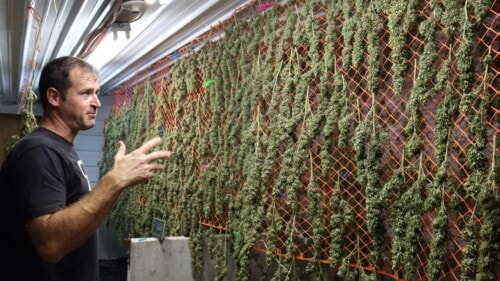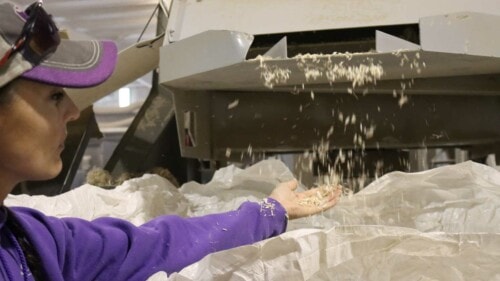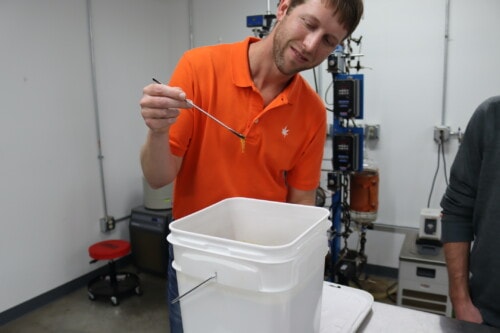‘Highway to Hemp’: Building, Making and Dreaming Big with Hemp Fiber Hemp-Based Alternative Materials Pop Up in Everything from Construction to Baking
Published February 3rd, 2022 at 6:00 AM
Above image credit: The possibilities for hemp-made products are near endless. (Cami Koons | Flatland)To Joe Bisogno, the founder of America’s Hemp Academy in De Soto, Kansas, hemp isn’t just trendy – it’s going to change the world.
What other material, he enthuses, can be used to build houses, make sustainable tampons, create a biodegradable plastic, line the insides of luxury cars or bake into a nutrient dense cookie?
“I tell every person I know, ‘If you’re a young person and you’re not involved with hemp, you’re crazy,’” Bisogno said. “It’s going to be the biggest thing that ever happened to America.”
Ask anyone in the hemp industry and they’ll tell you the fiber and grain side of the business is on the cusp of exploding.
Earlier in the “Highway to Hemp” series, Flatland looked at a fiber and grain processing facility in Great Bend, Kansas, the first step in converting the crop into products. Once the grain has been stripped and the fiber pulled apart from the hurd, or the woody inner stem via decortication, the raw materials can go into just about anything.
Building With Hemp
Since the 2018 Farm Bill, which legalized the farming of industrial hemp, hempcrete, also known as hemplime, has quickly become a trend in sustainable construction across the nation.
The concrete-like material uses a mineral base with small pieces of hemp hurd. It’s relatively new to the U.S., but it’s been used around the world since Roman times.
Phelan Dalton, the co-founder of Hemp Building Co. in Colorado, started the company in late 2019 after learning how to build with hempcrete and deciding to make a business that offered the materials and the know-how of hemp construction.
Why build with hemp?
For starters, it’s non-combustible and fireproof, which is especially attractive for Coloradans like Dalton after forest fires in recent years destroyed houses across the state.
“I’m not saying that if they were made from hempcrete that it wouldn’t have happened, but I think it’s definitely time to start considering more fireproof materials like hempcrete,” Dalton said.
There are a plethora of YouTube videos of people torching a block of hempcrete for hours. The dense material barely even smokes under the flame.
Fire Resistant
Hempcrete structures also retain their thermal qualities for centuries, whereas conventional insulation will sag and require replacing every couple of decades. It’s also an alkaline material, meaning the walls are not hospitable to mold or pests.
More than that, hempcrete is incredibly sustainable. It’s made entirely out of natural materials. The inner woody hurd of the hemp stalk is broken up into wood-chip like pieces, then mixed with lime mineral binder and water to make a concrete-like material.
While it’s growing, hemp takes in carbon dioxide, which is then trapped in the cells of the plant once harvested. All plants do this during photosynthesis, but because hemp grows so quickly, it “eats” more carbon than most other plants.
Once poured in place, the hemplime also sequesters more carbon as it dries and solidifies.
A hempcrete wall acts as the inner face, the insulation and the outer face of the wall, thereby consolidating three building materials into one. This can cut down on the number of people a builder needs to hire for separate jobs, but building a hempcrete wall is not without its own labor.
Hempcrete can come in the form of premade bricks, be sprayed in place or cast in place via bucket brigade, which Dalton said is his favorite method.
While it looks like concrete, Dalton said hempcrete is not structural. This means a foundation and frame must be put in place before hempcrete, or more accurately called hemplime, can be poured in.
Once the house is fully framed, and the basic electricity and plumbing put in place, the hemplime is mixed on site. Then buckets of the mixture are carried over to the framework, put up by the Hemp Building Co. team, and poured in.

Then the row of wet hempcrete is tamped down. This is repeated until the wall is the desired height.
The walls then have to dry and harden. Depending on the climate, this can take 12 weeks or more.
Once it’s fully dried, a plaster is applied to both the insides and outsides of the walls to finish it off.
While the inside doesn’t have the sheetrock most folks are used to, Dalton said you can still hang a picture or a shelf in a hempcrete wall. The plaster allows the material to remain permeable, keeping the hemp from getting too moist and allowing its natural thermal properties to insulate the house.
“I know a few builders that they’re just so used to the conventional way of construction that I guess partly they don’t have time to do a training class and kind of rethink the way that they’ve been trained and they’ve been successful,” Dalton said. “And it also can be a labor intensive building method.”
Right now, Dalton said hemp builds, depending on region and size, are usually slightly more expensive than conventional building costs. For a DIY builder who just wants to purchase materials, it can cost about $10-$12 per cubic foot, with the labor and equipment factored in, he said it would run $25-$30 per cubic foot.

“We’re paying somewhat of a premium currently for the hurd, just because it’s not bountiful at the moment,” Dalton said. “As we figure out the proper building methods and we have more contractors to work with, I think that the cost of building hempcrete houses could be cheaper than actually conventional stick frame houses.”
When he first started the business, Dalton said he had to ship hemp hurd from Europe. Everyone regionally was growing hemp for CBD, which isn’t ideal for hempcrete or other fibrous manufacturing.
For hempcrete houses to become more common, it will require more farmers growing hemp, and more processing facilities to work with farmers and break down the massive bales of dried hemp.
“We’re already seeing more and more interest every day,” Dalton said. “As we get industry behind it and build out infrastructure for processing hemp or brick manufacturing, I think because of the versatility of hempcrete, it can enter mainstream markets.”
His company is still young, with only five or so builds under its belt. But Dalton expects more companies will start building with hemp as they realize the benefits of the material.
“I am very optimistic about the future,” Dalton said.
If putting hemp in the walls isn’t enough, you can also use it for floors.
Greg Wilson, founder and CEO of HempWood, a Kenntucky-based company, is doing just that.
Wilson said the first thing most of his customers do when they see his product, is to smell it.
They’re expecting the hemp composite wood to have the same dank smell associated with marijuana. They also usually ask him what happens if the hempwood catches fire, expecting him to report that the firefighter will come out stoned.
“Now I say, ‘That costs extra,’” Wilson laughed. “That is an everyday question.”

Hempwood, like hempcrete, is a highly sustainable alternative to traditional building materials.
To make hempwood, dried hemp stalks are fed through a roller, which breaks apart the woody core and the fibrous outside. These bundles are then soaked in a soybean-based, non-toxic adhesive.
Wilson, whose background is in bamboo flooring, explained that traditional composite flooring methods would use formaldehyde or other toxic chemicals as an adhesive.
Now coated in the soybean adhesive, the hemp stalks are dried before being compressed into six-inch by six-inch logs, which are then baked to activate the adhesive.
The thick, compressed and baked hempwood logs rest for several weeks before the HempWood team cuts them down to flooring or other board sizes.
The final product is comparable to white oak, maple or black walnut hardwood flooring. After several years of scaling the company, Wilson said HempWood flooring is now competitively priced with the often sought tree-based flooring, at about $10 per square foot.
But here’s where hempwood shines over traditional hardwoods. It’s 20-30% denser than oak, which also makes it about 20% harder. Moreover, hemp grows about 100 times faster than traditional hardwood trees.

The potential for hemp is so great, that often folks will get ahead of themselves, and speculate that it will be cheaper and better than all of the products currently on the market.
“Speculate all you want, but the reality is it’s not going to be cheaper than the competition out there,” Wilson said. “The reality is, things don’t become cheaper on a dollar by dollar basis than something that’s been around for hundreds of years.”
He also noted that cheaper prices, or mass produced products, mean manufacturers have to take certain shortcuts, or substitute natural materials for chemicals. These are all things he saw happen in the bamboo flooring industry, and he doesn’t want to happen to his business.
“I can make my product 20% cheaper per square foot by using formaldehyde instead of a soy protein for the glue, but that’s not something we want to do,” Wilson said.
For Wilson, non-toxic materials are essential. His former work in the flooring industry meant he was frequently exposed to formaldehyde. Even today his respiratory function is damaged from being around the chemicals.
It’s not something he ever wants to bring into his products.

Wilson’s hempwood is showing up in noteworthy places, however. It was featured in the flooring at a BMW showcase of its sustainable materials, he has a contract with Chipotle to build hempwood stools in select restaurants, and Target has built displays in its stores using the sustainable wood.
Big name companies adopting hemp products helps to normalize hemp and make more consumers aware of the alternative material.
The lumber shortages brought on by the pandemic have also been great for companies like HempWood. People aren’t going to replace a pine two-by-four with a hempwood, but they might start to search for wood alternatives when traditional lumber prices have more than doubled, according to Fortune.
“Has it directly caused an increase in sales? I cannot say. But it has directly increased the number of people googling wood alternatives,” Wilson said. “So that is a very good thing for us.”
“Alternative” is the key word in the hemp industry. Wilson said the businesses that last work hemp into their existing business, rather than try to reinvent the wheel.
Baking With Hemp
Bisogno decided to bring hemp to an industry he was already familiar with: food.
The Goodcents founder, in addition to starting America’s Hemp Academy in De Soto, Kansas, has started a line of frozen baked goods, all using hemp flour.
Hemp flour is made from the grain, or the seeds of a hemp plant. This part of the plant does not have the cannabinoids that many are wary of when talking about hemp. Cannabidoil (CBD), Tetrahydrocannabinol (THC) and other cannabinoids are all produced in the flowers of the plant. Hemp grain has none of these properties.

Even so, Bisogno found that in focus groups, people still don’t trust a product that says hemp.
When presented with cookies, tortillas and pizza crust labeled as “made with hemp” most participants respond they would never buy the products for their family because they don’t want to give their children drugs.
The response was completely different, however, when Bisogno presented the products as “plant based” instead.
“This product is amazing,” Bisogno said. “We just have to get people to understand that it’s not a drug. It’s not going to hurt anyone. It’s going to help everyone.”
The baked goods look and taste similar to those baked with regular flour, only Bisogno said these plant-powered goodies offer higher nutritional value thanks to the high protein and potassium and healthy fats found in hemp seeds.
Bisogno said he’s even had American Bakers Association seminars in his warehouse to promote hemp flour in all sorts of baking practices. But the hemp grain is quite different from other grains. It requires a special mill, making it difficult for other flour manufacturers to jump on the hemp train.

This is actually true for a lot of industries. Bisogno said he’s spoken with many companies that are interested in adding hemp to their products, but can’t afford the risk in buying the specialized equipment to do so.
Biodegradable plastic-like material made from hemp could alleviate plastic pollution problems, but the bioplastic is just that, plastic-like. It can’t fit the same molds and techniques already in place by major manufacturers.
Given that it usually takes personal financing and risk to enter the hemp industry, Bisogno didn’t want to see people lose their life savings by not understanding hemp. In response, he started the academy, teaching growers, processors and manufacturers the skills they need to succeed.
“We’re not we’re not trying to be competitors to anyone, we’re trying to be educators to everyone,” Bisogno said.
Learning More About Hemp
Actually, the hemp industry as a whole is big on collaboration.
Because hemp has been outlawed for so long in the U.S., Dalton said collaboration is essential to the success of anyone entering the industry. Without it, they’d have nowhere to turn.
“It’s difficult to enter into the space just because of the lack of knowledge or lack of education, where to start, or what binder to use,” Dalton said. “But that’s something we’re working on.”
Throughout the year, Hemp Building Co. hosts workshops and invites builders and DIYers out to learn how to build with hemp.
“We’ve trained a lot of contractors and builders on the benefits and installation methods and the science behind building with hempcrete, in order to kind of break down that barrier of entry so that people know what they’re looking for,” Dalton said.
For the industry to reach its potential, it also means more consumers need to learn to understand hemp.
Patrick Van Meter just opened a processing facility in Missouri, Midwest Natural Fiber. He’s part of the solution to the immature supply chain, but before hemp can become universal, more farmers need to grow it, more processing facilities need to open and more manufacturers need to commit to using it.
“Getting to the scale we need, it’s a bigger challenge than a lot of people give credit to,” Van Meter said.
A lot of farmers and manufacturers are interested and want to enter the industry, but Van Meter said it’s not a one-for-one trade off. Hemp requires special equipment, pricey seeds and other such costs that can end up deterring those on both the agriculture and manufacturing side.
“It’s going to be an amazing market, but we just have to be very realistic,” Van Meter said.
Cami Koons covers rural affairs for Kansas City PBS in cooperation with Report for America. The work of our Report for America corps members is made possible, in part, through the generous support of the Ewing Marion Kauffman Foundation.






